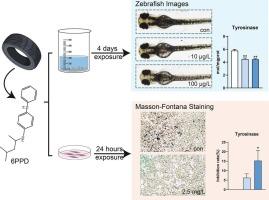6PPD exposure reduced the melanin deposition by inhibiting tyrosinase activity in larval zebrafish
IF 4.3
3区 环境科学与生态学
Q2 BIOCHEMISTRY & MOLECULAR BIOLOGY
Comparative Biochemistry and Physiology C-toxicology & Pharmacology
Pub Date : 2025-07-27
DOI:10.1016/j.cbpc.2025.110300
引用次数: 0
Abstract
N-(1,3-Dimethylbutyl)-N′-phenyl-p-phenylenediamine (6PPD), a critical antioxidant in rubber manufacturing, has raised global concerns due to its environmental persistence and toxic transformation products. While its developmental toxicity is increasingly recognized, the mechanisms underlying melanogenesis disruption in fish remain poorly understood. In this study, we systematically investigated 6PPD's effects on melanin synthesis in zebrafish embryos and murine melanoma cells (B16F10). Larval zebrafish were exposed to 10 and 100 μg/L 6PPD exhibited dose-dependent reductions in melanin deposition, suppressed tyrosinase activity and downregulation of melanogenesis-related genes (tyr, mitfa, trp1, trp2, and dct). Notably, the inhibition of tyrosinase activity was closely linked to behavioral impairments, as larvae exposed to 100 μg/L 6PPD showed significantly decreased swimming distance and velocity under light-dark cycles. Molecular docking revealed strong binding affinities between 6PPD and the key melanogenic proteins (Dct, Tyr, Tyrp1a, and Tyrp1b), suggesting direct interference with enzymatic function. Parallel experiments in B16F10 cells confirmed cross-species melanin suppression, with reduced gene expression and melanin synthesis-related protein (Mitfa and Tyr) at subtoxic concentrations (0.5 and 2.5 mg/L), which was also verified by Masson-Fontana staining. These findings demonstrated that 6PPD disrupted conserved melanogenic pathways by targeting enzymatic activity, posing ecological risks to aquatic and terrestrial organisms.

ppd暴露通过抑制斑马鱼幼鱼体内酪氨酸酶活性来减少黑色素沉积。
N-(1,3-二甲基丁基)-N'-苯基-对苯二胺(6PPD)是橡胶生产中重要的抗氧化剂,因其环境持久性和毒性转化产物而引起全球关注。虽然人们越来越认识到它的发育毒性,但对鱼类黑色素生成破坏的机制仍然知之甚少。在本研究中,我们系统地研究了6PPD对斑马鱼胚胎和小鼠黑色素瘤细胞(B16F10)黑色素合成的影响。6PPD浓度分别为10和100 μg/L时,斑马鱼幼鱼黑色素沉积呈剂量依赖性减少,酪氨酸酶活性受到抑制,黑色素形成相关基因(tyr、mitfa、trp1、trp2和dct)表达下调。值得注意的是,酪氨酸酶活性的抑制与行为障碍密切相关,暴露于100 μg/L 6PPD的幼虫在光暗循环下游泳距离和速度显著降低。分子对接发现6PPD与关键的黑色素生成蛋白(Dct、Tyr、Tyrp1a和Tyrp1b)具有很强的结合亲和性,提示其直接干扰酶的功能。在B16F10细胞中平行实验证实了跨物种黑色素抑制,亚毒性浓度(0.5和2.5 mg/L)下基因表达和黑色素合成相关蛋白(Mitfa和Tyr)降低,Masson-Fontana染色也证实了这一点。这些发现表明,6PPD通过靶向酶活性破坏保守的黑色素生成途径,对水生和陆生生物构成生态风险。
本文章由计算机程序翻译,如有差异,请以英文原文为准。
求助全文
约1分钟内获得全文
求助全文
来源期刊
CiteScore
7.50
自引率
5.10%
发文量
206
审稿时长
30 days
期刊介绍:
Part C: Toxicology and Pharmacology. This journal is concerned with chemical and drug action at different levels of organization, biotransformation of xenobiotics, mechanisms of toxicity, including reactive oxygen species and carcinogenesis, endocrine disruptors, natural products chemistry, and signal transduction with a molecular approach to these fields.

 求助内容:
求助内容: 应助结果提醒方式:
应助结果提醒方式:


